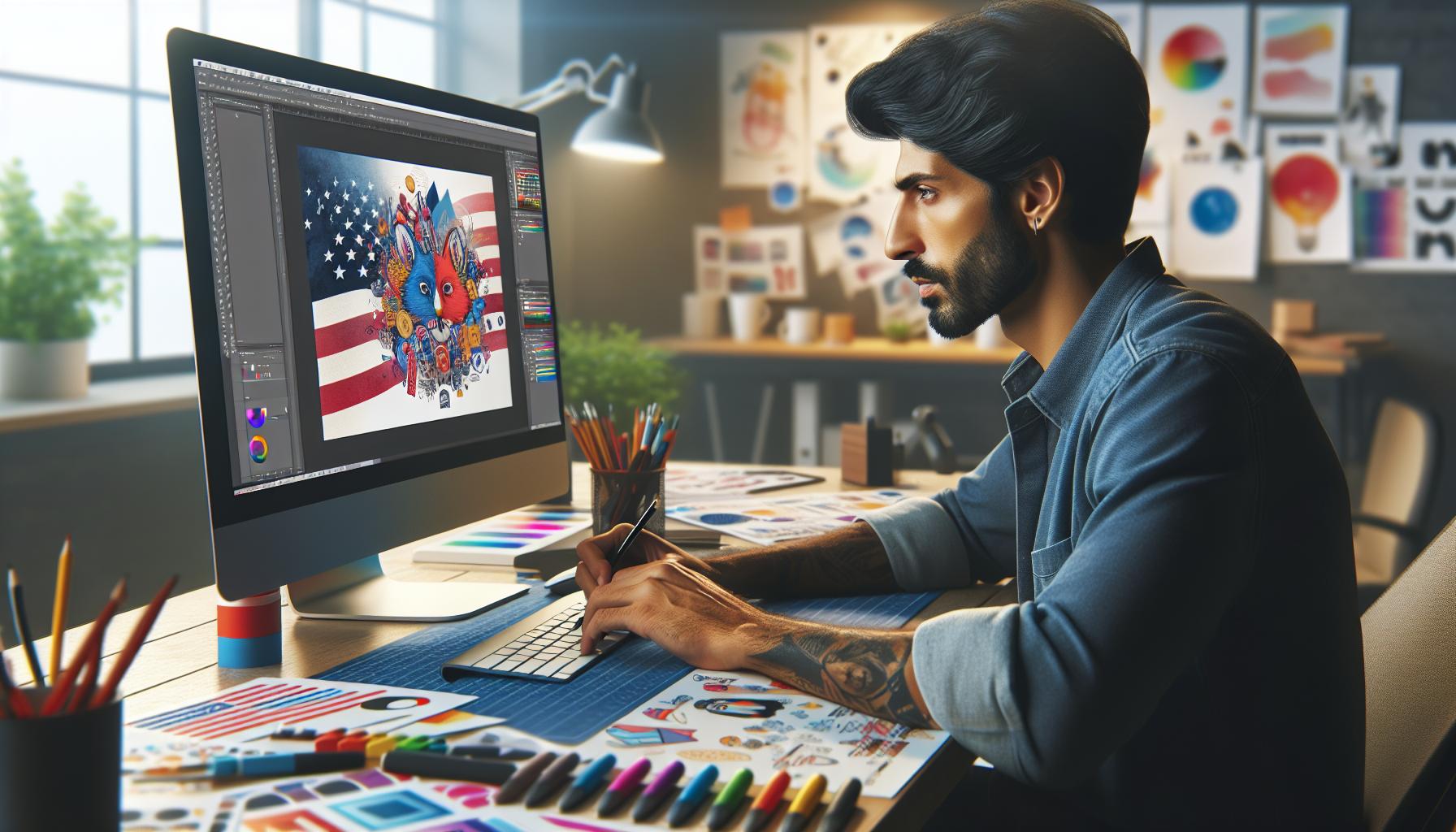In the vibrant world of graphic design, the right tools can make all the difference. Graphic designers rely on a variety of software to bring their creative visions to life, whether they’re crafting stunning visuals for print or designing captivating digital experiences. Understanding what software these professionals use is essential for anyone looking to enter the field or simply appreciate the artistry behind their favorite designs.
From industry-standard applications to innovative newcomers, the software landscape for graphic designers is both diverse and dynamic. Each program offers unique features tailored to different aspects of design, making it crucial for designers to choose the right tools for their specific needs. This article dives into the essential software that shapes the graphic design industry, providing insights into how these tools can elevate creativity and efficiency.
Key Takeaways
- Understanding Software Types: Graphic designers use various software for different tasks, including raster graphics (Adobe Photoshop), vector graphics (Adobe Illustrator), layout design (Adobe InDesign), and 3D modeling (Blender).
- Popular Software Choices: Adobe Creative Suite remains a staple, offering powerful tools for diverse design projects. Other notable options include CorelDRAW for vector graphics and Affinity Designer for a cost-effective solution.
- Emerging Trends: AI-driven tools, cloud-based solutions, and mobile applications are becoming essential in graphic design, enhancing creativity, collaboration, and accessibility.
- Choosing the Right Tools: Designers should assess their project types, complexity, and necessary features to select the most suitable software that enhances productivity and meets their unique needs.
- Sustainability in Design: There’s a growing focus on eco-friendly software solutions that promote sustainable design practices, reflecting the evolving ethics in the graphic design industry.
Overview Of Graphic Design Software
Graphic design software encompasses a wide range of applications tailored to meet various creative demands. These tools facilitate diverse tasks, including photo editing, vector graphic creation, and layout design. Key categories of graphic design software include:
- Raster Graphics Software
Raster graphics software focuses on pixel-based images. This software excels in photo editing and manipulation. Popular examples include Adobe Photoshop, Corel PHOTO-PAINT, and GIMP. - Vector Graphics Software
Vector graphics software operates using mathematical formulas to create scalable graphics. This type of software is ideal for logo design and illustrations. Leading options include Adobe Illustrator, CorelDRAW, and Affinity Designer. - Layout and Publishing Software
Layout and publishing software aids in creating multi-page documents and print materials. It streamlines the process of arranging text and images cohesively. Notable examples are Adobe InDesign, QuarkXPress, and Scribus. - 3D Modeling Software
3D modeling software enables designers to create three-dimensional graphics and animations. This software is useful for product visualization and game design. Renowned tools include Blender, Autodesk Maya, and Cinema 4D. - Web and UI/UX Design Tools
Web and UI/UX design tools facilitate the design of websites and user interfaces. These applications focus on functionality and user experience, enhancing digital interactions. Popular choices are Figma, Adobe XD, and Sketch. - Animation Software
Animation software allows designers to create animated graphics and motion designs. This software supports storytelling through visual media. Leading options include Adobe After Effects, Toon Boom Harmony, and Moho.
By employing the right graphic design software, designers can enhance their productivity and creativity, making informed choices based on their specific project requirements.
What Software do Graphic Designers Use

Graphic designers utilize various software tools tailored to their specific tasks. The following categories highlight essential software types and their functions in the design process.
Vector Graphics Software
Vector graphics software excels in creating scalable images without losing quality. Programs like Adobe Illustrator and CorelDRAW allow designers to create logos, icons, and illustrations using vector paths and points. These tools support precise control over shapes, colors, and typography. The non-pixelated nature of vector graphics makes them ideal for print designs and large-format graphics.
Raster Graphics Software
Raster graphics software specializes in editing and manipulating pixel-based images. Adobe Photoshop reigns as the industry standard, offering extensive features for photo editing, compositing, and retouching. GIMP and Affinity Photo serve as popular alternatives, catering to various budgets and skill levels. Designers use these tools for tasks like enhancing photographs, creating digital paintings, and designing web graphics. The pixel-based structure is crucial for detailed imagery but may lose quality when resized.
3D Modeling Software
3D modeling software creates three-dimensional designs and visualizations. Applications like Autodesk 3ds Max, Blender, and Cinema 4D allow designers to build, animate, and render 3D models. These tools apply to various fields, including product design, animation, and architecture. 3D graphics enhance marketing materials and provide dynamic visual content for websites and advertisements.
Popular Software Options

Graphic designers utilize various software options to enhance their workflows and outputs. Below are some of the most popular tools in the graphic design industry.
Adobe Creative Suite
Adobe Creative Suite remains a cornerstone for graphic designers. It includes powerful applications like Adobe Photoshop, Illustrator, and InDesign. Photoshop excels in raster editing and photo manipulation, allowing for precise adjustments and enhancements. Illustrator specializes in vector graphics, enabling the creation of scalable designs without quality loss. InDesign is integral for layout design, handling multi-page documents effectively with sophisticated typesetting features. These tools cater to a wide array of design needs, making Adobe Creative Suite a go-to solution.
CorelDRAW
CorelDRAW thrives in the realm of vector graphics. This software offers a user-friendly interface and powerful tools for creating illustrations, logos, and layouts. Designers favor its versatile features like advanced typography and color management. CorelDRAW supports multiple file formats, allowing for easy collaboration with other software. Its comprehensive toolkit and affordability make it a popular choice among both beginners and seasoned professionals.
Affinity Designer
Affinity Designer combines robust functionality with affordability. This graphic design software appeals to those seeking a one-time purchase rather than a subscription model. It supports both vector and raster graphics, making it versatile for various design projects. Users appreciate its smooth performance and real-time editing capabilities. Affinity Designer also features intuitive interface elements, aiding quick adaptation for new users.
Sketch
Sketch focuses on digital design, particularly for user interfaces and web applications. This vector-based software allows designers to build, prototype, and collaborate seamlessly. With features like symbols and reusable components, it streamlines the design process for UI/UX projects. Sketch integrates well with various plugins, enhancing functionality and efficiency during the design workflow. Designers often choose Sketch for its simplicity and emphasis on collaboration in team environments.
Emerging Trends In Graphic Design Software

Emerging trends in graphic design software reflect advancements in technology and changing user needs. Designers increasingly turn to artificial intelligence (AI) for enhancing creativity and optimizing workflows. AI-driven tools automate tasks like image recognition and design suggestions, allowing designers to focus on their core creative processes.
Cloud-based software solutions gain popularity for their accessibility and collaboration features. Tools like Adobe Creative Cloud and Figma enable teams to work simultaneously on projects from different locations. These platforms facilitate real-time feedback, enhancing communication among team members.
Augmented reality (AR) and virtual reality (VR) integration become more prevalent in design software. Programs combining AR and VR introduce immersive experiences, particularly for product design and marketing initiatives. Designers can visualize concepts in 3D environments, offering clients a unique perspective on potential outcomes.
Mobile applications emerge as vital tools for designers. User-friendly apps like Canva and Adobe Spark allow designers to create and edit graphics on-the-go, catering to the increasing demand for mobile-friendly design solutions. These apps empower both amateurs and professionals to produce visually appealing content quickly.
Sustainability becomes a focus in design, influencing software development. Eco-friendly tools that minimize digital waste and encourage sustainable practices attract designers committed to environmentally responsible work. Software developers now prioritize creating solutions that contribute to a more sustainable future.
Overall, these trends illustrate the ongoing evolution in graphic design software, highlighting how advancements in technology and shifting priorities shape the tools designers choose to use.
Choosing The Right Software For Your Needs
Selecting software tailored to individual design needs is crucial for graphic designers. Identifying specific requirements and preferred design styles influences software choices significantly.
Assessing Your Design Focus
- Graphic Types: Determine whether projects involve raster graphics or vector graphics. Raster graphics require software like Adobe Photoshop for pixel-based editing, while vector graphics call for Adobe Illustrator or CorelDRAW for scalable designs.
- Project Complexity: Analyze the complexity of the project. Simple designs fit well with basic tools, whereas intricate projects benefit from advanced software like Adobe InDesign for layout and publishing tasks.
Evaluating Features
- User Interface: Consider software with an intuitive interface. Tools with user-friendly designs promote efficiency, allowing more focus on creativity.
- Collaboration Tools: Evaluate collaboration features, particularly for teams. Cloud-based solutions, such as Figma or Adobe Creative Cloud, enable simultaneous work on projects from various locations.
- Compatibility: Check compatibility with existing workflows. Seamless integration with other software enhances productivity, especially when utilizing multiple applications.
Budget Considerations
- Pricing Models: Compare pricing models. Subscription-based software like Adobe Creative Cloud offers flexibility, while one-time purchase options like Affinity Designer may suit budget-conscious users.
- Trial Versions: Utilize trial versions of software before committing. Testing software firsthand provides insight into usability and functionality.
- Emerging Technologies: Stay updated on emerging technologies in graphic design software. AI-driven tools streamline tasks, cloud solutions enhance accessibility, and mobile applications cater to on-the-go design needs.
- Sustainability Practices: Consider software that promotes sustainable design practices. Eco-friendly digital tools minimize waste, reflecting contemporary ethical standards in design.
By aligning software choices with specific needs and current trends, graphic designers enhance their creative capabilities, fostering productivity and innovation in their projects.
Software is Crucial For Graphic Designers
Choosing the right software is crucial for graphic designers to maximize their creativity and efficiency. With a plethora of options available it’s essential for designers to align their software choices with their specific project needs and personal preferences. As technology continues to evolve new tools and features will emerge that can further enhance the design process.
Staying informed about the latest trends such as AI integration and cloud-based solutions will empower designers to adapt and thrive in an ever-changing landscape. By investing time in selecting the right tools designers can elevate their work and ensure they remain competitive in the graphic design industry.